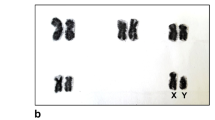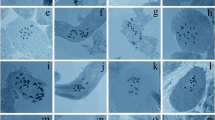Abstract
G-banded karyotypes were compared in the following species of Microtidae: Microtus nivalis; M. cabrerae; M. arvalis and Arvicola sapidus. Previous observations on A. sapidus and A. terrestris (Díaz de la Guardia & Pretel, Caryologia 32: 183–189, 1979) were also incorporated in this study. The results show that Robertsonian translocations and pericentric inversions are common mechanisms involved in the karyotypic evolution of this group. Interspecific differences in C-banding patterns were also analyzed. Using the karyograph method (Imai et al., Am. Nat. 121: 477–488, 1983), the evolutionary distances of the karyotypes were estimated, and an attempt was made to establish a presumptive phylogenetic tree.
Similar content being viewed by others
References
Ando, K., Tagawa, T. & Uchida, T. A., 1980. The C-banding pattern of 6 Japanese species of Vespertilionine bats (Mammalia: Chiroptera). Experientia 36: 653–654.
Baverstock, P. R., Gelder, D. & Jahnke, A., 1982. Cytogenetic studies of the Australian rodent, Uromys caudimaculatus, a species showing extensive heterochromatin variation. Chromosome 84: 517–533.
Benazzou, T., Viegas-Péquignot, E., Petter, F. & Dutrillaux, B., 1982a. Phyogénie chromosomique de quatre espèces de Meriones (Rongeurs, Gerbillidae). Ann. Génét. 25: 19–24.
Benazzou, T., Viegas-Péquignot, E., Petter, F. & Dutrillaux, B., 1982b. Phylogénie chromosomique des Gerbillidae. II Etude de six Meriones, de Taterillus gracilis et de Gerbillus titonis. Ann. Génét. 25: 212–217.
Bianchi, N. O. & Merani, S., 1984. Cytogenetics of South American Akodont rodents (Cricetidae). X. Karyological distances at generic and intergeneric levels. J. Mammal. 65: 206–219.
Buckland, R. A. & Evans, H. J., 1978. Cytogenetic aspects of phylogeny in the Bovidae. II. C-banding. Cytogenet. Cell Genet. 21: 64–71.
Capanna, E., 1982. Robertsonian numerical variation in animal speciation: Mus musculus an emblematic model. In: C.Barigozzi, ed. Mechanisms of speciation (Alan R. Liss, New York).
Chaline, J. & Matthey, R., 1971. Hypothèses relatives à la formule chromosomique d'Allophaiomys pliocaenicus (Rodentia, Arvicolidae) et à la diversification de cette espèce. C.R. Acad. Sc. Paris 272: 1071–1074.
Dev, V. J., Miller, D. A. & Miller, O. J., 1973. Chromosome markers in Mus musculus: strain differences in C-banding. Genetics 75: 663–670.
Diaz de la Guardia, R. & Pretel, A., 1979. Comparative study of the karyotypes of two species of water vole: Arvicola sapidus and Arvicola terrestris (Rodentia, Microtinae). Caryologia 32: 183–189.
Diaz de la Guardia, R., Pascual, L. & Orozco, J. C., 1979. The karyotype of Microtus cabrerae Thomas, another species with giant sex chromosomes. Experientia 35: 741.
Diaz de la Guardia, R., Burgos, M. & Jiménez, R., 1981. About the karyotype of Microtus nivalis Martins (Rodentia, Microtinae). Caryologia 34: 377–383.
Dutrillaux, B., Couturier, J. & Viegas-Péquignot, E., 1981. Chromosomal evolution in primates. In “Chromosomes Today” Vol. 7. (Proc. 7th Int. Chromosome Conference, Oxford 26–31 August 1980) (Ed. by M. D.Bennett, M.Bobrow & G.Hewitt). George Allen and Unwin, London, pp 176–191.
Forehjt, J., 1972. Giemsa specific centromeric heterochromatin in three inbred mouse strains. Folia biolog. 18: 213–215.
Fretias, T. O. R., Matevi, M. S., Oliveira, L. F. B., Souza, M. J., Yonenaga-Yasuda, Y. & Salvano, F. M., 1983. Chromosome relationships in three representatives of the genus Holochilus (Rodentia, Cricetidae) from Brazil. Genetic 61: 13–20.
Gamperl, R., 1982. Chromosomal evolution in the genus Clethrionomys. Genetica 57: 193–197.
Gamperl, R. & Vistorin, G., 1980. Comparative study of G-and C-banded chromosomes of Gerbillus campestris and Meriones unguiculatus (Rodentia, Gerbillinae). Genetica 52: 93–97.
Gileva, E. A., Bolshakov, V. N., Chernousova, N. F. & Mamina, V. P., 1982. Cytogenetical differentiation of forms in the group of Pamir (Microtus juldaschi) and Carruther's (M carruthersi) voles (Mammalia, Microtinae) Zool. Zh. 61: 912–922.
Gropp, A., Winking, H., Redi, C., Capanna, E., Britton-Davidian, J. & Noack, G., 1982. Robertsonian karyotype variation in wild house mice from Rhaeto-Lombardia. Cytogenet. Cell Genet. 34: 67–77.
Hsu, T. C. & Benirschke, K., 1970. An atlas of mammalian chromosomes, vol. 4, Berlin; Springer-Verlag.
Hsu, T. C., Markvong, A. & Marshall, J. T., 1978. G-band patterns of six species of mice belonging to subgenus Mus. Cytogenet. Cell Genet. 20: 304–307.
Imai, H., Maruyama, T. & Crozier, R. H., 1983. Rates of mammalian karyotype evolution by the karyograph method. Am. Nat. 121: 477–488.
Jüdes, U., 1981. G- and C-band karyotypes of the harvest mouse, Micromys minutus. Genetica 54: 237–239.
King, M. & John, B., 1979. Regularities and restrictions governing C-band variation in acridoid grasshoppers. Chromosoma 76: 123–150.
Král, B., Zima, J., Herzig-Straochi, B. & Sterba, O., 1979. Karyotypes of certain small mammals from Austria. Folia zool. 28: 5–11.
Lee, M. R. & Elder, F. F. B., 1980. Yeast stimulation of bone marrow mitosis for cytogenetic investigations. Cytogenet. Cell. Genet. 26: 36–40.
Mandahl, N. & Fredga, K., 1975. Q-, G- and C-band patterns of mink chromosomes. Hereditas 81: 211–220.
Mandahl, N. & Fredga, K., 1980. A comparative chromosome study by means of G- C- and NOR-bandings of the weasel, the pygmy weasel and the stoat (Mustela, Carnivora, Mammalia). Hereditas 93: 75–83.
Matthey, R., 1957. Cytologie comparée, systématique et phylogénie des Microtinae (Rodentia, Muridae). Rev. suisse Zool. 64: 39.
Matthey, R., 1973. The chromosome formulae of eutherian mammals. In: Cytotaxonomy and vertebrate evolution, Ed. A. B.Chiarelli & F.Capanna. Academic Press, London and New York.
Miklos, G. L. G., Willcocks, D. A. & Baverstock, P. R., 1980. Restriction endonuclease and molecular analysis of three bat genomes with special reference to chromosome rearrangement and speciation problems. Chromosoma 76: 339–363.
Nadler, C. F., Lyapunova, E. A., Hoffmann, R. S., Vorontsov, N. N., Shaitarova, L. L. & Borisov, Y. M., 1984. Chromosomal evolution in holarctic ground squirrels (Spermophilus). Z. Säugetierkd 4(2): 78–90.
Orlov, V. N. & Malygin, V. M., 1969. Two forms of the 46-chromosome Microtus arvalis Pall. In: N. N.Vorontsov, ed. The mammals—evolution, karyology, taxonomy, fauna. Acad. Sc. U.S.S.R., Novosibirsk: pp. 143–144.
Pathak, S., Hsu, T. C. & Arrighi, F. E., 1973. Chromosomes of Peromyscus (Rodentia, Cricetidae). IV. The role of heterochromatin in karyotype evolution. Cytogenet. Cell Genet. 12: 313–326.
Patton, J. L. & Sherwood, S. W., 1982. Genome evolution in pocket gophers (Genus Thomomys). I. Heterochromatin variation and speciation potential. Chromosoma 85: 149–162.
Raicu, P., Kirillova, M. & Hamar, M., 1969. A new chromosomal sex-determining mechanism in Microtus arvalis Pallas. Genetica 40: 97–102.
Savic, I., Soldatovic, B. & Dulic, B., 1971. On the karyotype of the species Microtus arvalis Pallas, 1779 (Rodentia, Microtidae). From Vojvodina Arhiv Biolokih nauka 3: 27–28.
Sen, S. & Sharma, T., 1983. Role of constitutive heterochromatin in evolutionary divergence: results of chromosome banding and condensation inhibition studies in Mus musculus, Mus booduga and Mus dunni. Evolution 37(3): 628–636.
Seabright, M., 971. A rapid banding technique for human chromosomes. Lancet 2: 971–972.
Sumner, A. T., Evans, H. J. & Buckland, R., 1971. New technique for distinguishing between human chromosomes. Nature New Biol. 232: 31–32.
Sumner, A. T., 1972. A simple technique for demonstrating centromeric heterochromatin. Expl Cell Res. 75: 304–306.
Viegas-Péquignot, E., Benazzou, T., Dutrillaux, B. & Petter, F., 1982. Complex evolution of sex chromosomes in Gerbillidae (Rodentia). Cytogenet. Cell Genet. 34: 158–167.
Wurster-Hill, D. H. & Centerwall, W. R., 1982. The interrelationships of chromosome banding patterns in canids, mustelids, hyena and felids. Cytogenet. Cell Genet. 34: 178–192.
Yosida, T. H. & Sagai, T., 1975. Variation of C-bands in the chromosomes of several subspecies of Rattus rattus. Chromosoma 50: 283–300.
Zima, J. & Kral, B., 1984. Karyotypes of European Mammals II. Acta Sc. Nat. Brno 18(8): 13–29.
Author information
Authors and Affiliations
Rights and permissions
About this article
Cite this article
Burgos, M., Jiménez, R. & Diaz de la Guardia, R. Comparative study of G- and C-banded chromosomes of five species of Microtidae. Genetica 78, 3–12 (1986). https://doi.org/10.1007/BF00058668
Received:
Accepted:
Issue Date:
DOI: https://doi.org/10.1007/BF00058668




